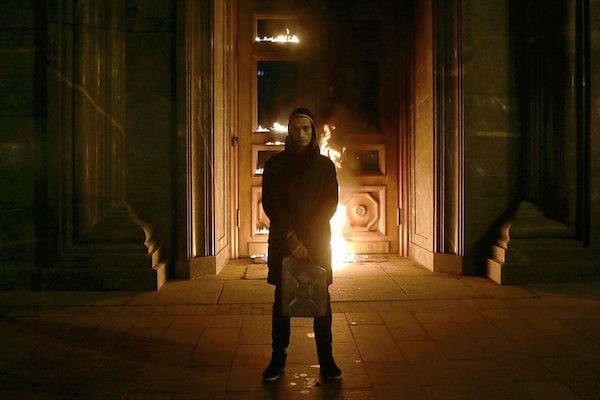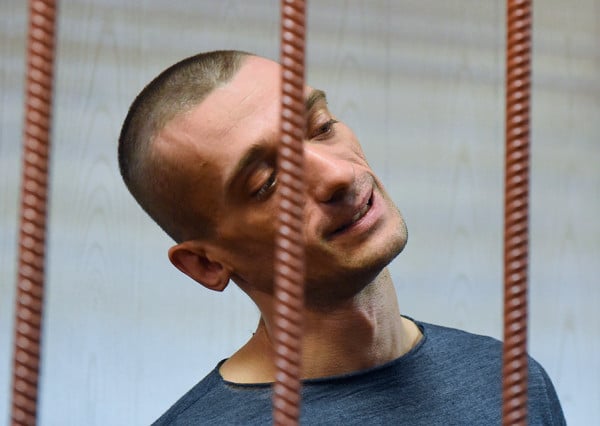Law & Politics
Artist Pyotr Pavlensky Could Win Russian Security Services’ Prize for Burning Their Doors
For now, the FSB is going along with it.

For now, the FSB is going along with it.

Naomi Rea

Russian artist Pyotr Pavlensky, infamous for his extreme performance art that challenges the Russian government, has been nominated for the Russian Security Services’ (FSB) Prize for Literature and the Arts.
It’s a strange move. The FSB, successor to the KGB, is currently holding Pavlensky, pending trial, for vandalism charges relating to the same work nominated for the prize.
The performance in question, Threat: Lubyanka’s Burning Door, saw Pavlensky set fire to the doors of the FSB in November of last year.
The inflammatory work has made headlines before. In February, Russian officials cancelled the Innovatsiya (Innovation) Prize, Russia’s top art prize, because the controversial artistic protest was nominated. The state-funded National Center for Contemporary Arts rejected the nomination of Pavlensky’s work, citing the reason that it involved “breaches of the law and caused material damage.” Pavlensky’s rejected nomination saw walk outs from the selection committee for the Innovatsiya, who agreed to return on the condition that the art category of the prize be eliminated this year.

Pyotr Pavlensky sewed his lips shut in protest at the prosecution of Pussy Riot in the summer of 2012. Photo courtesy of Pyotr Pavlensky via the Quietus.
Now, the FSB have inexplicably accepted the nomination of Pavlensky’s work for their own prize, The Russian Security Services’ Prize for Literature and the Arts, which commends artistic work on the subject of the FSB, reports the Moscow Times.
The nomination came courtesy of Maria Baronova, a co-ordinator of the “Open Russia” human rights project, who confirmed that Pavlensky’s nomination had already been accepted.

Pyotr Pavlensky is removed by police from the roof of Moscow’s Serbsky psychiatric center, after cutting his earlobe off. Photo via: Oksana Shalygina’s Facebook.
The controversial performance artist is notorious for drawing attention to what he believes is the corruption of the Russian state. In the summer of 2012, he sewed his lips shut in protest of the prosecution of punk-rock activists Pussy Riot.
Pavlensky’s work often involves self-mutilation. In 2013, he nailed his scrotum to the cobblestones of Moscow’s Red Square in protest of the government, and, in 2014, cut off his own earlobe to protest the forced psychiatric treatment on Russian political dissidents.

Russian artist Pyotr Pavlensky, accused of vandalism after torching the doors to the headquarters of the FSB security service, stands inside a defendants’ cage during a hearing at a court in Moscow on November 10, 2015. Photo: Dmitry Serbryakov/AFP/Getty Images.
The artist is no stranger to playing with fire, either. In February of 2014, in his work Freedom, Pavlensky set fire to some tires on a St. Petersburg bridge in solidarity with the Euromaiden protests in Kiev, which denounced the Russian occupation of Crimea. The political stunt saw Pavlensky arrested and found guilty of vandalism earlier this month, but the artist dodged jail time on a technicality: the statute of limitations for criminal responsibility relating to his case had expired.
Pavlensky’s provocative art not only draws attention to where he sees the Russian government lacking, but prompts important conversations about the tenuous boundaries between activism, vandalism, and performance art. Last year his extreme political message spoke to Pavel Yasman, the young investigator in charge of interrogating him after the bridge stunt. Yasman was persuaded by Pavlensky’s incendiary work, and quit his job at Russia’s Investigative Committee to become a lawyer.